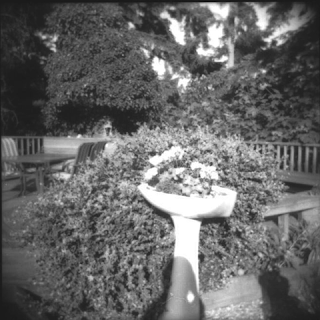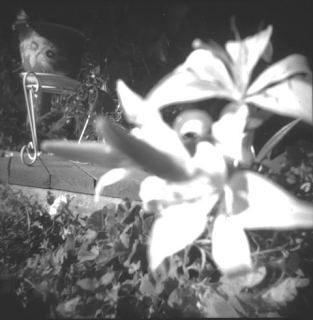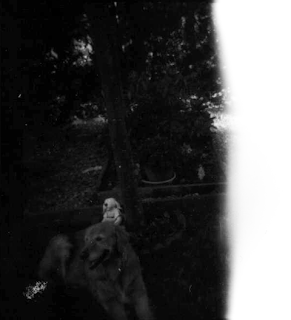 After printing contact sheets for the first rolls of film Susan had shot, I had my first dilemma.
After printing contact sheets for the first rolls of film Susan had shot, I had my first dilemma.During the summer the academic schedule is short (only seven weeks), meaning the darkroom was open on a limited schedule. There was no hope of enlarging all the images during summer quarter. I would have to choose a couple from each roll and wait until the next quarter to make any additional prints.
Was it up to me to decide which images would be printed? I am sighted, so I would be making judment based on what I myself interpreted to be interesting and/or thought-provoking. It seemed to me this unfairly edited what Susan had begun, but I could see no way around it. I think each photographer always has a few shots in a roll that they really bond with emotionally during the shoot. If I could find these shots, I might be on the right track.
 With limited time, I also elected not to print on archival quality paper. I instead used RC paper, the thickly-coated, not-so-attractive resinous paper used more for speed of processing.
With limited time, I also elected not to print on archival quality paper. I instead used RC paper, the thickly-coated, not-so-attractive resinous paper used more for speed of processing.This was disappointing, not only from the standpoint of print quality (as fiber paper produces a much richer and more textured image), but from the process itself. While each step takes much longer than RC paper, it is quite a pleasant process, an artistic process. The paper is optically more sensitive and allows less room for clumsiness. In addition to being expensive, it is also thick and fragile. One must pay critical attention to the paper facing, exposure times, filters, times in chemicals and in washing, handling with tongs, rinsing, and be aware of dry-down (the factor by which the image darkens as the paper dries).
On the other hand, working with RC paper had a distinct advantage. It is bulletproof and has a much better chance of surviving over-development, tonging, scratches, and the like. When lab hours are shorter, the darkroom is packed every minute and becomes kind of a pressure cooker. The medium you print with can be a determinant of success ....
Feverish students slam their prints from tank to tank, tonging the prints, flipping them over in their hurry to find their own, and contaminating tanks by insufficiently draining prints while moving them. A fiber print in this environment needs weaponized babysitting. With 14 enlarging stations in the larger of the darkrooms, the room almost bounces with energy -- especially on days when someone tunes the boom box to trash-talk radio. A day spent guarding fiber prints can leave an artist wondering what part of art they were just experiencing.
 As a social experiment, the classroom darkroom is the only place I've encountered where so much time is spent in baloney contests. A young man, waiting for his prints to process, will state an outrageous opinion of some obscure fact. A second will throw down another inflated opinion, and the aggressiveness of his assertion will either lead to the first person throwing in additional information or to his backing down in awe of the new arrival's mastery of his subject. And it can keep going. The best way to avoid all this is to walk away, except that in the darkroom, the timing of the prints keeps us all captive -- which might be the point. We're the audience. (You can always tell a seasoned photographer: they're the ones wearing headphones.)
As a social experiment, the classroom darkroom is the only place I've encountered where so much time is spent in baloney contests. A young man, waiting for his prints to process, will state an outrageous opinion of some obscure fact. A second will throw down another inflated opinion, and the aggressiveness of his assertion will either lead to the first person throwing in additional information or to his backing down in awe of the new arrival's mastery of his subject. And it can keep going. The best way to avoid all this is to walk away, except that in the darkroom, the timing of the prints keeps us all captive -- which might be the point. We're the audience. (You can always tell a seasoned photographer: they're the ones wearing headphones.) As I went through the print process, I realized I had another decision to make: should I use standard filtering and composing methods to improve on the negatives, to bring out the theoretical best in each print? I decided this would be a mis-representation of "theoretical best" and how the subjects came together into their composition.
As I went through the print process, I realized I had another decision to make: should I use standard filtering and composing methods to improve on the negatives, to bring out the theoretical best in each print? I decided this would be a mis-representation of "theoretical best" and how the subjects came together into their composition.When I looked at Susan's film, I could see a pleasant happenstance of composition. Susan was composing each of her shots with considerable thought and care, and with a great attention to detail. But in addition to the composed subject matter it was obvious Susan was attracting some happy circumstances to each photo. It could be the velvet touch of the sun on a leaf, or the fact that Nellie was walking out of the frame when the photo was taken, making for a sweet gesture. In each photo there was something that was a "happening" -- an attraction, if you will -- that had the touch of the divine.
In the end, I used filters to bring out the texture of each shot, but I did not correct across the print for areas of exposure. This, I thought, was an artifact of shooting by feel and it should definitely be part of the resulting image.
This project was to be all about the printed image, but in the end, I realized that I could scan the contact sheets and post digitally the images I was not able to print during this first time in the darkroom.
That posed an entirely new set of dilemmas....
No comments:
Post a Comment
Add your comment:
Note: Only a member of this blog may post a comment.